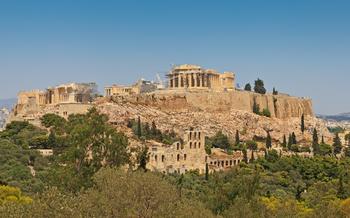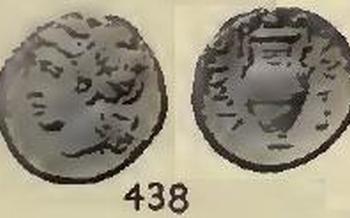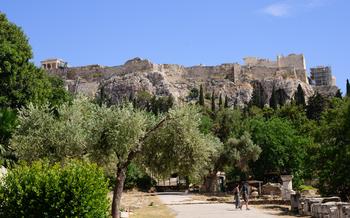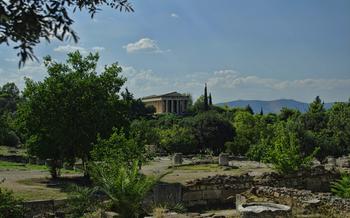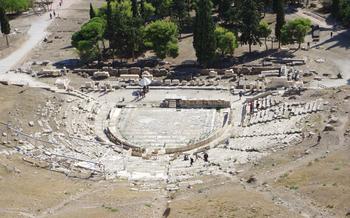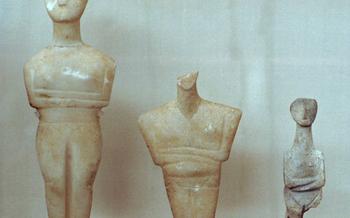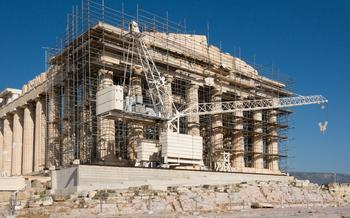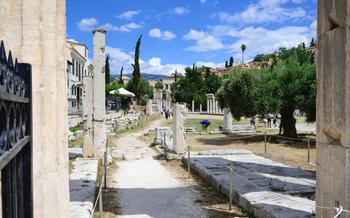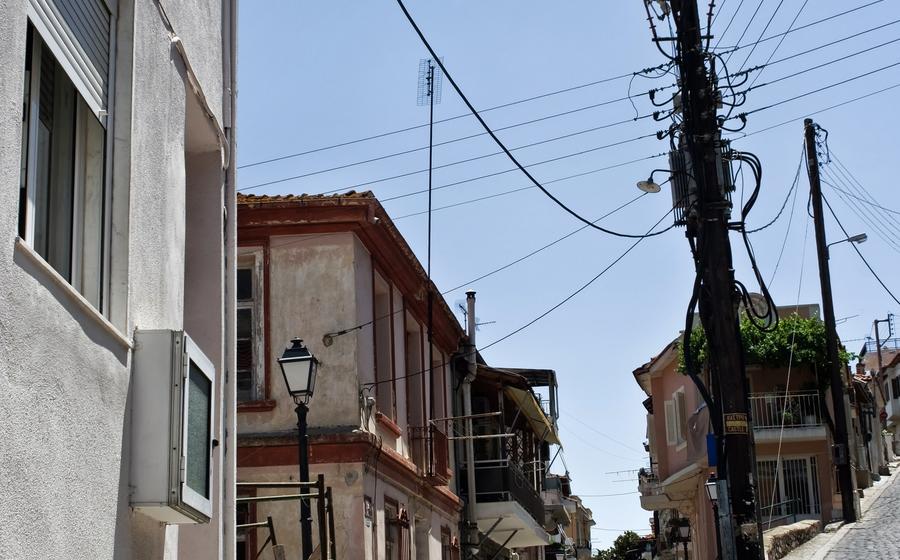
The Ancient Agora of Thassos
- The Ancient Agora of Thassos: A Journey Through Time
- Unveiling the Heart of Thasos
- A Stroll Through History: The Agora's Monuments
- Echoes of Democracy: The Agora's Political Role
- Gods and Goddesses: The Agora's Religious Significance
- Marketplace and Beyond: The Agora's Economic Activities
- Social Hub: The Agora as a Meeting Place
- Architectural Masterpieces: The Agora's Buildings
- Excavating the Past: Archaeological Discoveries
- The Agora's Legacy: Influence on Modern Democracy
- Virtual Explorations: Online Resources
- Capturing the Essence: Photography Tips
- The Agora in Literature and Art
- Events and Festivals: Bringing the Agora to Life
- Insider Tip: Hidden Gem
The Ancient Agora of Thassos: A Journey Through Time
In the heart of Thassos, an island steeped in ancient history, lies the remarkably preserved Ancient Agora of Thassos, a testament to the remarkable civilization that flourished here centuries ago. As one of the best-preserved agoras in Greece, this captivating site offers a glimpse into the political, cultural, commercial, and social life of this ancient city-state.
Nestled between the picturesque harbor and the Acropolis, the Agora served as the central public space, a bustling hub where citizens gathered for political assemblies, conducted business, celebrated religious festivals, and engaged in lively debates. Its strategic location facilitated easy access for both locals and visitors, ensuring its pivotal role in the daily life of Thassos.
Archaeological excavations conducted over several decades have unearthed a treasure trove of artifacts and structures, shedding light on the Agora's rich history and significance. These discoveries, including inscriptions, statues, and architectural remains, have provided invaluable insights into the functioning of this ancient marketplace and civic center.
Among the must-see highlights within the Agora are the impressive Stoa, a colonnaded walkway where merchants displayed their goods, the Bouleuterion, where the city council convened, and the Prytaneion, the government building where officials dined and conducted official business. These structures, along with other intriguing features, await exploration, inviting visitors to embark on a captivating journey through time.
Unveiling the Heart of Thasos
The Ancient Agora of Thassos served as the bustling heart of the city, a vibrant public space where political, commercial, and social activities intertwined. As the central meeting place, the Agora played a pivotal role in shaping the civic life of Thasos.
The Agora's layout reflected its multifunctional character. The impressive Stoa, a long, colonnaded structure, provided shelter from the sun and rain, creating a conducive environment for political assemblies and discussions. The Bouleuterion, or Council House, was the venue for deliberations by the city council, where important decisions affecting the city's governance were made.
The Prytaneion, a building dedicated to the city's officials, served as a symbol of civic authority and hospitality. Within the Agora, altars and shrines dedicated to various deities were scattered, reflecting the religious significance of the space and the integration of religion into everyday life.
The Agora's architectural features showcased the skill and ingenuity of Thasos's builders. The use of local materials, such as marble and limestone, lent a distinctive character to the Agora's structures. The Agora's design and layout allowed for efficient movement and interaction among citizens, facilitating trade, political discourse, and social gatherings.
In comparison to other ancient Agoras, the Agora of Thasos stands out for its well-preserved state and the variety of activities that took place within its confines. The Agora of Athens may be more renowned, but the Agora of Thasos offers a more intimate and immersive experience, allowing visitors to connect with the daily lives and interactions of Thasos's ancient inhabitants.
A Stroll Through History: The Agora's Monuments
The Ancient Agora of Thassos was adorned with impressive monuments that served various functions and reflected the city's prosperity and civic pride. One of the most striking structures was the Stoa, a long, covered walkway lined with shops and stalls. The Stoa provided shelter from the sun and rain, allowing merchants to conduct their businesses comfortably.
Another significant monument was the Bouleuterion, or Council House. This building served as the meeting place for the city's council, where important decisions were made regarding the governance of Thassos. The Bouleuterion was a symbol of the city's democratic system, showcasing the importance of citizen participation in decision-making.
The Prytaneion, or Government Building, was another essential structure within the Agora. It housed the city's administrative offices and served as a place for officials to conduct their duties. The Prytaneion also played a religious role, as it was the site of the sacred hearth, where a perpetual fire was kept burning in honor of the city's patron deities.
In addition to these major monuments, the Agora featured various other structures, each with its own unique purpose. These included temples dedicated to various gods, altars for religious ceremonies, and statues honoring prominent citizens or deities. The Agora's monuments collectively showcased the city's wealth, power, and commitment to civic life.
Echoes of Democracy: The Agora's Political Role
The Ancient Agora of Thassos was not just a marketplace or a social hub; it was also the heart of the city's political life. Thassos was a democracy, and the Agora served as the central gathering place for citizens to exercise their democratic rights and responsibilities.
Assembly meetings were held regularly in the Agora, where citizens would come together to discuss and debate important issues affecting their city. These meetings were open to all free male citizens, and decisions were made based on the majority vote. The Agora was also the location for electing officials, who were chosen by the citizens to represent their interests and carry out the decisions made in the Assembly.
The Agora's political role was crucial to the functioning of Thasos's democracy. It provided a platform for citizens to voice their opinions, participate in the decision-making process, and hold their elected officials accountable. This democratic system, which originated in the Agora, served as a model for other ancient Greek city-states and has had a profound influence on the development of modern democracy.
Comparing the democratic system practiced in Thasos with other ancient democracies, such as Athens, reveals both similarities and differences. While both cities held Assembly meetings in their respective Agoras, Athens had a more complex system of government, with a larger Assembly and a more formalized process for electing officials. However, both cities shared the fundamental principles of citizen participation, debate, and majority rule, which were essential to the functioning of their democratic systems.
Gods and Goddesses: The Agora's Religious Significance
The Agora of Thassos was not just a place of commerce and politics; it was also a sacred space deeply intertwined with religious beliefs and practices. Altars and shrines dedicated to various deities, such as Zeus, Athena, and Apollo, were scattered throughout the Agora. These altars served as places for citizens to offer sacrifices, prayers, and libations to the gods, seeking their favor and protection.
Religious ceremonies and festivals were an integral part of life in the Agora. These events brought the community together to celebrate the gods, honor their achievements, and ask for their blessings. The most important of these festivals was the annual Dionysia, dedicated to the god Dionysus, which featured processions, theatrical performances, and communal feasting.
The integration of religion into civic life was a defining characteristic of the Agora. The presence of religious structures and rituals in the heart of the city symbolized the deep connection between the political and spiritual aspects of ancient Greek society. The Agora was not just a place of earthly affairs but also a place where the divine and the human intersected.
The religious significance of the Agora is reflected in its design and layout. The placement of altars and shrines in prominent positions within the Agora suggests their importance in the daily lives of the citizens. The orientation of the Agora towards the rising sun may also have had religious implications, as the sun was associated with Apollo, the god of light and prophecy.
Understanding the religious significance of the Agora provides a deeper appreciation of the multifaceted nature of this ancient public space. It was not just a center of commerce and politics but also a sacred place where the community came together to honor their gods, celebrate their festivals, and seek divine guidance and protection.
Marketplace and Beyond: The Agora's Economic Activities
The Ancient Agora of Thassos was not just a place for political and social gatherings but also a bustling marketplace. Economic activities thrived within the Agora, contributing significantly to the city's economy.
Rows of shops and stalls lined the streets, offering a diverse range of goods and services. Merchants from across the region and beyond traded their wares, creating a vibrant atmosphere of commerce. Visitors could find everything from fresh produce and livestock to imported luxuries, pottery, and textiles.
The Agora also served as a hub for financial transactions. Money changers and bankers set up their tables, facilitating currency exchange and financial dealings. Market regulations and standards ensured fair trade practices and protected the rights of both buyers and sellers.
The Agora's economic significance extended beyond Thassos itself. It played a crucial role in regional trade, connecting Thassos with other cities and islands. The exchange of goods and ideas fostered economic growth and cultural exchange throughout the region.
Exploring the Agora's economic dimension offers a glimpse into the bustling commercial activities that sustained ancient Thassos. From the bustling marketplaces to the financial transactions, the Agora was a vibrant hub of economic activity, contributing to the prosperity and interconnectedness of the ancient world.
Social Hub: The Agora as a Meeting Place
The Agora, beyond its political and economic significance, served as a vibrant social hub for the citizens of Thasos. It was a place where people from all walks of life congregated to socialize, exchange ideas, and forge connections. Philosophers engaged in intellectual discourse, sharing their thoughts on various subjects, while merchants and traders exchanged not only goods but also stories and experiences from their travels. The Agora facilitated a sense of community, where individuals could come together, discuss matters of mutual interest, and strengthen their bonds.
The Agora's social significance extended beyond mere conversations and gatherings. It was a place where cultural influences intermingled, as people from different backgrounds and perspectives came together. Through these interactions, new ideas were born, and the Agora became a catalyst for cultural exchange and innovation. The Agora's role as a social hub contributed to the overall richness and dynamism of Thasos' society, fostering a sense of belonging and unity among its citizens.
Architectural Masterpieces: The Agora's Buildings
The Agora of Thassos showcases a remarkable array of architectural masterpieces, each reflecting the ingenuity and artistry of ancient Greek builders. Constructed using locally sourced materials, including marble and limestone, these buildings exhibit a harmonious blend of functionality and aesthetics. The Agora's architectural style predominantly features classical Greek elements, characterized by symmetry, proportion, and the use of columns and pediments.
One of the most striking features of the Agora is its impressive Stoa, a long, colonnaded walkway that provided shelter from the sun and rain. The Stoa's Doric columns and intricate capitals create a sense of grandeur and elegance. The Bouleuterion, or Council House, is another architectural highlight, featuring a semi-circular seating arrangement and a raised platform for speakers. Its well-preserved acoustics allowed for effective communication during assembly meetings.
The Prytaneion, the government building, is distinguished by its elaborate facade and spacious interior. It served as the administrative center of the city, housing government officials and hosting official functions. Other notable structures within the Agora include temples, altars, and various shops and stalls, each contributing to the Agora's vibrant and diverse architectural landscape.
The Agora's buildings stand as a testament to the architectural prowess of the ancient Greeks. Their enduring beauty and functionality continue to captivate visitors, offering a glimpse into the advanced urban planning and construction techniques of this remarkable civilization.
Excavating the Past: Archaeological Discoveries
The Ancient Agora of Thassos has been a rich site for archaeological excavations, yielding a wealth of significant artifacts that have shed light on the Agora's history and importance. Systematic excavations began in the late 19th century and have continued intermittently over the decades, revealing a treasure trove of ancient remains.
Among the notable discoveries are inscriptions, sculptures, pottery fragments, coins, and other artifacts that provide valuable insights into the Agora's political, economic, and social life. These findings have helped to reconstruct the Agora's layout, identify the functions of its various structures, and understand the daily activities that took place within its walls.
One of the most significant discoveries was a large marble stele, known as the "Thasian Decree", which dates back to the 5th century BC. This stele contains a detailed record of a treaty between Thasos and its neighboring city-states, providing valuable information about the political and diplomatic relations of Thasos during the Classical period.
Another important find was a well-preserved statue of Hermes, the Greek god of trade and travel, which was unearthed near the Agora's entrance. This statue suggests that the Agora was not only a center of commerce but also had a religious significance, as it was customary to place statues of deities in public spaces for veneration.
The ongoing archaeological excavations at the Ancient Agora of Thassos continue to uncover new artifacts and insights, contributing to our understanding of this remarkable site and its role in the history of Thasos and the wider ancient Greek world.
The Agora's Legacy: Influence on Modern Democracy
The ancient Agora of Thassos stands as a testament to the enduring power of democracy. Its legacy extends far beyond the boundaries of ancient Greece, shaping the political systems and democratic ideals of modern societies. The Agora's principles of citizen participation, free speech, and collective decision-making laid the foundation for modern democratic institutions.
The democratic ideals that flourished in the Agora were disseminated throughout the ancient world, influencing the development of democratic systems in other city-states and empires. The democratic legacy of the Agora was carried forward by thinkers and statesmen such as Aristotle, who drew inspiration from the Athenian model of democracy.
In the modern era, the principles of democracy, equality, and citizen participation that were nurtured in the Agora have been embraced by nations around the world. The Agora's legacy can be seen in the establishment of democratic governments, the adoption of constitutional rights and freedoms, and the promotion of democratic values such as freedom of expression, assembly, and association.
The Agora's influence on modern democracy is not merely symbolic; it is a living legacy that continues to shape the way we govern ourselves. The principles of democracy that were born in the Agora have stood the test of time, proving their resilience and adaptability in the face of changing circumstances.
As we navigate the challenges of the modern world, the Agora's legacy reminds us of the enduring power of democratic ideals. The principles of citizen participation, accountability, and the rule of law that were nurtured in the Agora remain essential for building just and inclusive societies.
Virtual Explorations: Online Resources
The Ancient Agora of Thassos, with its rich history and captivating monuments, is not just a physical site but also a treasure trove of knowledge accessible through various online resources. These digital platforms offer virtual tours, interactive maps, 3D reconstructions, and online exhibits that allow you to explore the Agora from the comfort of your home.
Websites such as the official website of the Greek Ministry of Culture and Sports provide detailed information, images, and historical context about the Agora. Virtual tours, like those offered by Google Arts & Culture, take you on a guided journey through the Agora's ruins, providing panoramic views and close-up examinations of key structures.
Interactive maps and 3D reconstructions, such as those created by the University of Southampton, allow you to navigate the Agora's layout, explore individual buildings, and visualize the site as it may have appeared in ancient times. These immersive experiences bring the Agora to life, giving you a sense of its scale and grandeur.
Digital resources, such as academic papers, articles, and online courses, offer in-depth insights into the Agora's history, architecture, and significance. These resources are valuable for researchers, students, and anyone interested in delving deeper into the Agora's complexities.
The benefits of virtual exploration are numerous. It allows you to access the Agora regardless of your location or physical limitations. It also provides a safe and controlled environment for learning and exploration, especially for those unable to visit the site in person.
So, whether you're a history buff, an archaeology enthusiast, or simply curious about ancient Greece, these online resources offer a wealth of opportunities to explore and appreciate the Ancient Agora of Thassos from anywhere in the world.
Capturing the Essence: Photography Tips
The Ancient Agora of Thassos presents a treasure trove of photographic opportunities. To capture its grandeur and essence, consider using a wide-angle lens to encompass the vastness of the site. Experiment with different angles to highlight specific structures or to convey the Agora's scale and layout.
Pay attention to lighting conditions. Early morning or late afternoon light often produces warm, golden tones that enhance the Agora's weathered surfaces. Utilize natural light to create dramatic shadows and depth in your images.
To capture the details of architectural features, such as intricate carvings or inscriptions, use a macro lens. This will allow you to showcase the craftsmanship and artistry that went into the construction of the Agora's buildings.
Don't forget to capture the surrounding landscape. The Agora is nestled amidst lush greenery and offers stunning views of the sea. Including these elements in your photographs will provide context and a sense of place.
Finally, remember to experiment and have fun. The Agora is a photographer's paradise, so take your time, explore different angles, and let your creativity flow. Your photographs will not only serve as a record of your visit but also as a way to share the beauty and significance of this ancient site with others.
The Agora in Literature and Art
The Ancient Agora of Thassos has served as a rich source of inspiration for artists and writers throughout history. In ancient Greek literature, the Agora is frequently mentioned as a setting for important events and gatherings. Playwrights such as Euripides and Aristophanes used the Agora as a backdrop for their comedies and tragedies, bringing to life the bustling atmosphere and lively debates that took place within its walls.
In the realm of visual arts, the Agora has been depicted in numerous paintings, sculptures, and mosaics. Ancient Greek artists often incorporated the Agora into their works, using it as a symbol of civic life and democracy. These artistic representations provide valuable insights into the appearance and significance of the Agora in ancient times.
In contemporary literature, the Agora continues to captivate the imaginations of writers. Novelists, poets, and historians have explored the Agora's rich history and legacy in their works. By delving into the stories and experiences of the people who once frequented the Agora, these works bring the ancient marketplace to life for modern readers.
Whether through ancient texts, paintings, sculptures, or contemporary literature, the Agora remains a potent symbol of democracy, civic engagement, and cultural exchange. Its enduring presence in art and literature speaks to its profound impact on society and its continuing relevance in the modern world.
Events and Festivals: Bringing the Agora to Life
In addition to its historical significance and architectural wonders, the Ancient Agora of Thassos is also a vibrant cultural hub that hosts a variety of events and festivals throughout the year. These events offer visitors a unique opportunity to experience the Agora's rich heritage and traditions firsthand.
One of the most popular events is the annual Thasos Agora Festival, which takes place during the summer months. The festival features a variety of cultural performances, including traditional Greek dances, music, and theater. Visitors can also enjoy traditional Greek food, crafts, and games.
Another popular event is the Agora Symposium, which brings together scholars and experts from around the world to discuss the history, archaeology, and culture of the Agora. The symposium features lectures, workshops, and panel discussions, providing visitors with an in-depth understanding of the Agora's significance.
Throughout the year, the Agora also hosts a variety of other events, including concerts, art exhibitions, and historical reenactments. These events offer visitors a chance to experience the Agora's vibrant atmosphere and learn more about its rich history.
Whether you're interested in history, culture, or simply experiencing the lively atmosphere of a traditional Greek festival, be sure to check out the events calendar for the Ancient Agora of Thassos. You're sure to find something that interests you.
Insider Tip: Hidden Gem
While exploring the Agora, make sure to seek out the hidden gem known as the "Temple of Dionysus." Tucked away in a secluded corner of the site, this small but significant temple offers a glimpse into the religious practices of ancient Thasos. Dedicated to the Greek god of wine, theater, and fertility, Dionysus, the temple features well-preserved architectural elements and intricate carvings that provide insights into the artistic and religious traditions of the time. Take a moment to pause and admire the temple's facade and imagine the rituals and ceremonies that once took place within its sacred walls.
